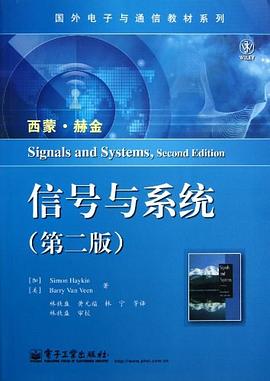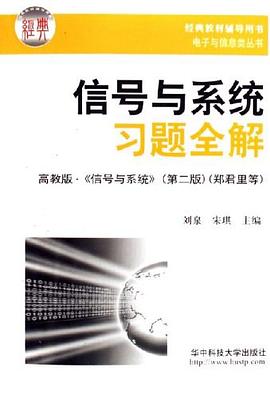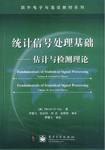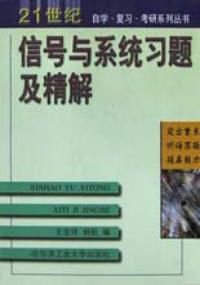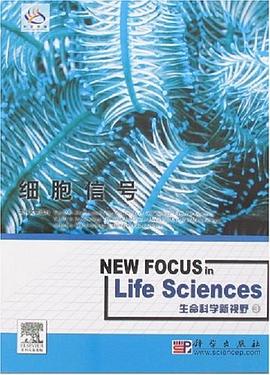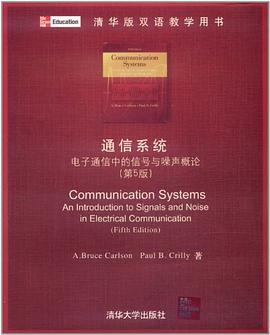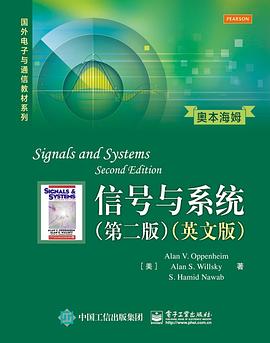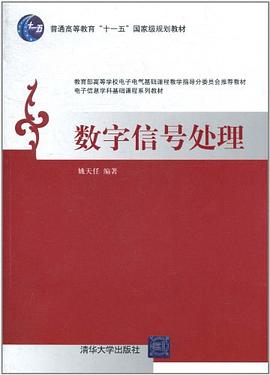

具体描述
Signals, Systems and Inference is a comprehensive text that builds on introductory courses in time- and frequency-domain analysis of signals and systems, and in probability. Directed primarily to upper-level undergraduates and beginning graduate students in engineering and applied science branches, this new textbook pioneers a novel course of study. Instead of the usual leap from broad introductory subjects to highly specialized advanced subjects, this engaging and inclusive text creates a study track for a transitional course. Properties and representations of deterministic signals and systems are reviewed and elaborated on, including group delay and the structure and behavior of state-space models.
The text also introduces and interprets correlation functions and power spectral densities for describing and processing random signals. Application contexts include pulse amplitude modulation, observer-based feedback control, optimum linear filters for minimum mean-square-error estimation, and matched filtering for signal detection. Model-based approaches to inference are emphasized, in particular for state estimation, signal estimation, and signal detection. The text explores ideas, methods and tools common to numerous fields involving signals, systems and inference: signal processing, control, communication, time-series analysis, financial engineering, biomedicine, and many others. Signals, Systems, and Inference is a long-awaited and flexible text that can be used for a rigorous course in a broad range of engineering and applied science curricula.
作者简介
目录信息
Acknowledgments
Prologue
1 Signals and Systems
1.1 Signals, Systems, Models, and Properties
1.1.1 SystemProperties
1.2 Linear,Time-InvariantSystems
1.2.1 Impulse-Response Representation of LTI Systems
1.2.2 Eigenfunction and Transform Representation of LTISystems
1.2.3 FourierTransforms
1.3 Deterministic Signals and Their Fourier Transforms
1.3.1 Signal Classes and Their Fourier Transforms
1.3.2 Parseval’s Identity, Energy Spectral Density, andDeterministicAutocorrelation
1.4 Bilateral Laplace and Z-Transforms
1.4.1 The Bilateral z-Transform
1.4.2 The Bilateral Laplace Transform
1.5 Discrete-Time Processing of Continuous-Time Signals
1.5.1 Basic Structure for DT Processing of CT Signals
1.5.2 DT Filtering and Overall CT Response
1.5.3 NonidealD/CConverters
1.6 FurtherReading
2 Amplitude, Phase, and Group Delay
2.1 Fourier Transform Magnitude and Phase
2.2 Group Delay and the Effect of Nonlinear Phase
2.2.1 Narrowband Input Signals
2.2.2 Broadband Input Signals
2.3 All-PassandMinimum-Phase Systems
2.3.1 All-PassSystems
2.3.2 Minimum-Phase Systems
2.4 SpectralFactorization
2.5 FurtherReading
3 Pulse-Amplitude Modulation
3.1 Baseband Pulse-Amplitude Modulation
3.1.1 TheTransmittedSignal
3.1.2 TheReceivedSignal
3.1.3 Frequency-Domain Characterizations
3.1.4 Intersymbol Interference at the Receiver
3.2 NyquistPulses
3.3 Passband Pulse-Amplitude Modulation
3.3.1 Frequency-Shift Keying (FSK)
3.3.2 Phase-ShiftKeying (PSK)
3.3.3 Quadrature-Amplitude Modulation (QAM)
3.4 FurtherReading
4 State-Space Models
4.1 SystemMemory
4.2 IllustrativeExamples
4.3 State-SpaceModels
4.3.1 DTState-SpaceModels
4.3.2 CTState-SpaceModels
4.3.3 Defining Properties of State-Space Models
4.4 State-Space Models from LTI Input-Output Models
4.5 Equilibria and Linearization of Nonlinear State-Space Models
4.5.1 Equilibrium
4.5.2 Linearization
4.6 FurtherReading
5 LTI State-Space Models
5.1 Continuous-Time and Discrete-Time LTI Models
5.2 Zero-Input Response and Modal Representation
5.2.1 UndrivenCTSystems
5.2.2 UndrivenDTSystems
5.2.3 Asymptotic Stability of LTI Systems
5.3 General Response in Modal Coordinates
5.3.1 DrivenCTSystems
5.3.2 DrivenDTSystems
5.3.3 Similarity Transformations and Diagonalization
5.4 Transfer Functions, Hidden Modes, Reachability, and Observability
5.4.1 Input-State-Output Structure of CT Systems
5.4.2 Input-State-Output Structure of DT Systems
5.5 FurtherReading
6 State Observers and State Feedback
6.1 Plant andModel
6.2 StateEstimationandObservers
6.2.1 Real-TimeSimulation
6.2.2 TheStateObserver
6.2.3 ObserverDesign
6.3 StateFeedbackControl
6.3.1 Open-LoopControl
6.3.2 Closed-Loop Control via LTI State Feedback
6.3.3 LTIStateFeedbackDesign
6.4 Observer-Based Feedback Control
6.5 FurtherReading
7 Probabilistic Models
7.1 The Basic Probability Model
7.2 Conditional Probability, Bayes’ Rule, and Independence
7.3 Random Variables
7.4 Probability Distributions
7.5 Jointly Distributed Random Variables
7.6 Expectations,Moments, andVariance
7.7 Correlation and Covariance for Bivariate Random Variables
7.8 A Vector-Space Interpretation of Correlation Properties
7.9 FurtherReading
8 Estimation
8.1 Estimation of a Continuous Random Variable
8.2 FromEstimates totheEstimator
8.2.1 Orthogonality
8.3 Linear Minimum Mean Square Error Estimation
8.3.1 Linear Estimation of One Random Variable from a Single Measurement of Another
8.3.2 Multiple Measurements
8.4 FurtherReading
9 Hypothesis Testing
9.1 Binary Pulse-Amplitude Modulation in Noise
9.2 Hypothesis Testing with Minimum Error Probability
9.2.1 Deciding with Minimum Conditional Probability of Error
9.2.2 MAP Decision Rule for Minimum Overall Probability of Error
9.2.3 Hypothesis Testing in Coded Digital Communication
9.3 BinaryHypothesisTesting
9.3.1 False Alarm, Miss, and Detection
9.3.2 The Likelihood Ratio Test
9.3.3 Neyman-Pearson Decision Rule and Receiver Operating Characteristic
9.4 MinimumRiskDecisions
9.5 FurtherReading
10 Random Processes
10.1 Definition and Examples of a Random Process
10.2 First- and Second-Moment Characterization of Random Processes
10.3 Stationarity
10.3.1 Strict-SenseStationarity
10.3.2 Wide-SenseStationarity
10.3.3 Some Properties of WSS Correlation and Covariance Functions
10.4 Ergodicity
10.5 Linear Estimation of Random Processes
10.5.1 LinearPrediction
10.5.2 LinearFIRFiltering
10.6 LTIFilteringofWSSProcesses
10.7 FurtherReading
11 Power Spectral Density
11.1 Spectral Distribution of Expected Instantaneous Power
11.1.1 PowerSpectralDensity
11.1.2 FluctuationSpectralDensity
11.1.3 Cross-SpectralDensity
11.2 Expected Time-Averaged Power Spectrum and the Einstein-Wiener-KhinchinTheorem
11.3 Applications
11.3.1 Revealing Cyclic Components
11.3.2 ModelingFilters
11.3.3 WhiteningFilters
11.3.4 Sampling Bandlimited Random Processes
11.4 FurtherReading
12 Signal Estimation
12.1 LMMSE Estimation for Random Variables
12.2 FIRWienerFilters
12.3 TheUnconstrainedDTWienerFilter
12.4 CausalDTWienerFiltering
12.5 Optimal Observers and Kalman Filtering
12.5.1 CausalWiener Filtering of a Signal Corrupted by Additive Noise
12.5.2 Observer Implementation of theWiener Filter
12.5.3 Optimal State Estimates and Kalman Filtering
12.6 EstimationofCTSignals
12.7 FurtherReading
13 Signal Detection
13.1 Hypothesis Testing with Multiple Measurements
13.2 Detecting a Known Signal in I.I.D. Gaussian Noise
13.2.1 TheOptimalSolution
13.2.2 CharacterizingPerformance
13.2.3 MatchedFiltering
13.3 Extensions of Matched-Filter Detection
13.3.1 Infinite-Duration, Finite-Energy Signals
13.3.2 Maximizing SNR for Signal Detection in White Noise
13.3.3 DetectioninColoredNoise
13.3.4 Continuous-Time Matched Filters
13.3.5 Matched Filtering and Nyquist Pulse Design
13.3.6 Unknown Arrival Time and Pulse Compression
13.4 Signal Discrimination in I.I.D. Gaussian Noise
13.5 FurtherReading
Bibliography
Index
· · · · · · (收起)
读后感
评分
评分
评分
评分
用户评价
相关图书
本站所有内容均为互联网搜索引擎提供的公开搜索信息,本站不存储任何数据与内容,任何内容与数据均与本站无关,如有需要请联系相关搜索引擎包括但不限于百度,google,bing,sogou 等
© 2025 book.quotespace.org All Rights Reserved. 小美书屋 版权所有




